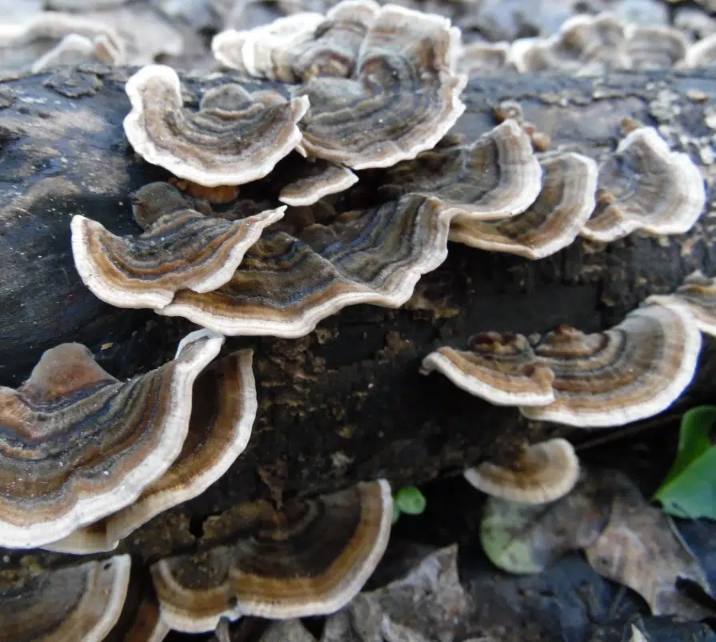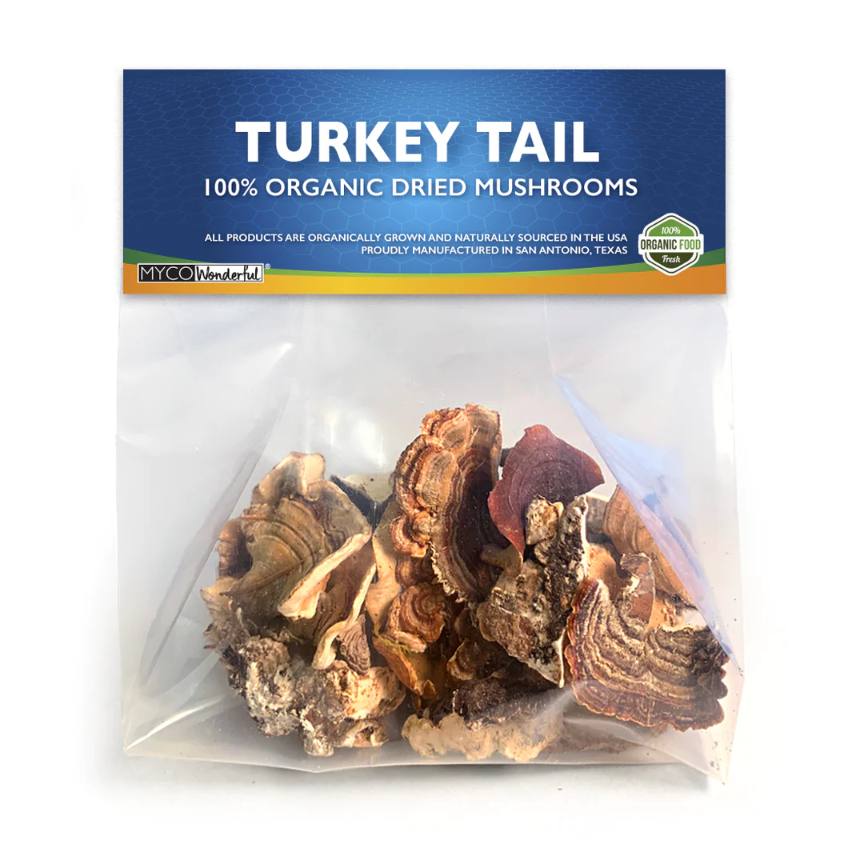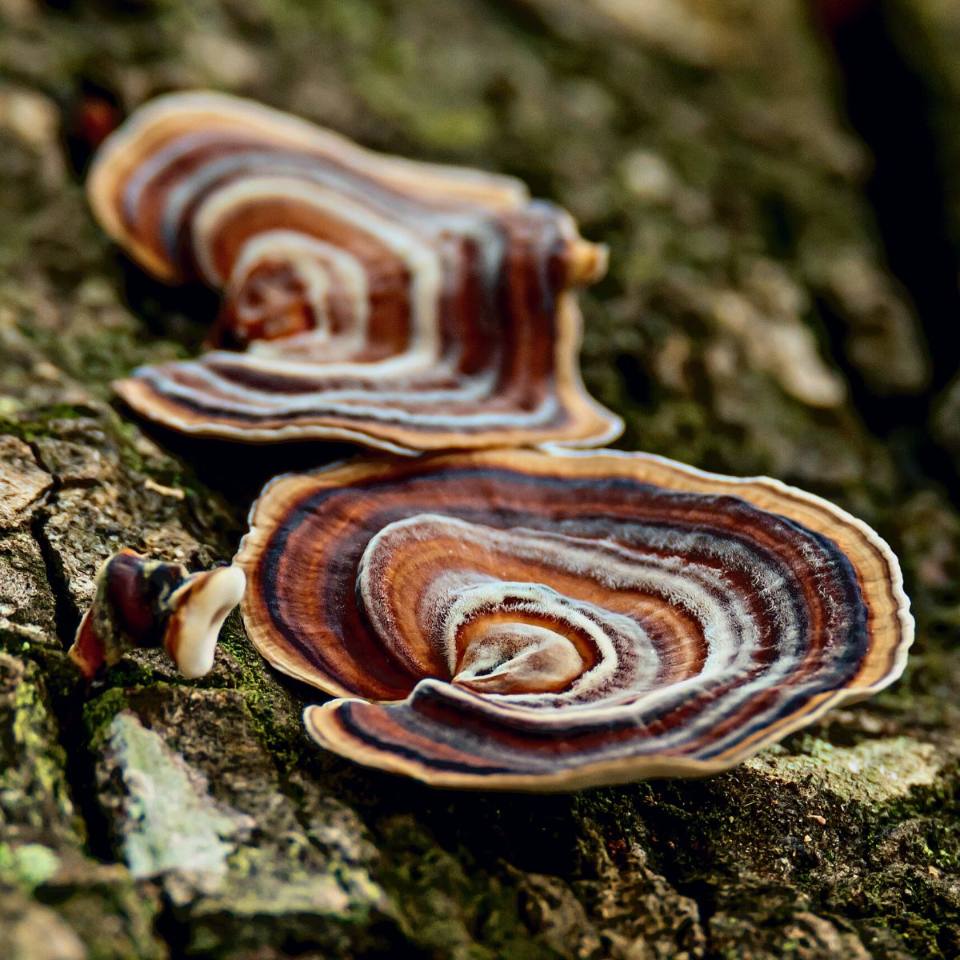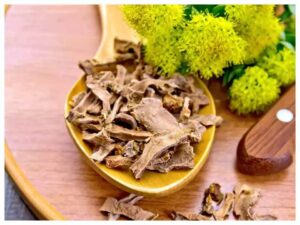
The Perplexing Discovery of Trametes Versicolor
Unearthing a Mysterious Fungus
Trametes versicolor, commonly known as the turkey tail mushroom, is a multi-colored bracket fungus found in forests throughout the world. Its striking colors, ranging from deep blues and greens to bright yellows and oranges, make it a popular subject for nature enthusiasts and artists alike. However, the discovery of this peculiar fungus was anything but straightforward.
The history of Trametes versicolor is shrouded in mystery and controversy, with conflicting reports about its origin and early discovery. Some sources claim that the fungus was first identified in China more than 2,000 years ago, where it was used in traditional medicine to treat a wide range of ailments. Others argue that it was known to the ancient Greeks and Romans, who valued it for its medicinal properties.
Despite these claims, the first documented discovery of Trametes versicolor did not occur until the late 18th century, when European explorers began to chart the flora and fauna of the Americas. It was during this time that the fungus was first observed by Western scientists, who were immediately struck by its unique appearance and potential medical applications.
Early Observations and Medical Applications
The first recorded description of Trametes versicolor comes from the Swedish botanist Olof Swartz, who encountered the fungus during his travels in the Caribbean in the late 1780s. Swartz noted that the fungus was commonly used by local healers to treat a variety of illnesses, including fever, dysentery, and cancer.
Swartz was not the only scientist to take an interest in Trametes versicolor. In the early 19th century, the French mycologist Augustin Pyramus de Candolle conducted extensive studies of the fungus, noting its ability to produce a bitter-tasting substance known as “polysaccharide-K” (PSK). De Candolle believed that PSK had powerful anti-tumor properties, and he recommended the use of Trametes versicolor in cancer treatment.
Controversy and Confusion
Despite the early interest in Trametes versicolor, the discovery of the fungus remained shrouded in confusion and controversy for many years. Some researchers believed that the fungus was actually a collection of different species, each with its own distinct characteristics and medical applications. Others argued that the fungus was a mere curiosity, with little practical value beyond its aesthetic appeal.
It was not until the mid-20th century that the true nature of Trametes versicolor began to emerge. In 1965, Japanese scientists discovered a compound in the fungus known as “Krestin,” which was later found to have powerful immunomodulatory properties. Krestin, also known as “PSK,” was found to boost the immune system and improve the survival rates of cancer patients.
The Importance of Trametes Versicolor
Today, Trametes versicolor is recognized as one of the most important medicinal fungi in the world. Its unique properties have been extensively studied by scientists, who have identified a wide range of potential medical applications. In addition to its anti-tumor and immunomodulatory effects, Trametes versicolor has been found to have anti-inflammatory, anti-viral, and antioxidant properties.
The discovery of Trametes versicolor is a testament to the power of scientific inquiry and exploration. Despite centuries of confusion and controversy, scientists were able to unlock the secrets of this mysterious fungus, revealing a wealth of potential medical benefits. Today, Trametes versicolor continues to captivate researchers and nature enthusiasts alike, offering a glimpse into the wonders of the natural world.
Further Research and Commercial Applications
The discovery of Trametes versicolor has sparked a great deal of interest among scientists and researchers, leading to further exploration of its potential medical applications. In recent years, there has been a surge of interest in the use of Trametes versicolor in cancer treatment, with several clinical trials showing promising results.
In addition to its potential medical benefits, Trametes versicolor is also of commercial interest due to its use in the production of dietary supplements and other natural health products. The fungus is often sold in capsule or powder form, marketed for its immune-boosting and antioxidant properties.
Future Research and Conservation Efforts
Despite the many advances made in the study of Trametes versicolor, there is still much to be learned about this mysterious fungus. Scientists continue to explore its potential medical applications, and efforts are underway to better understand its ecology and biology.
Conservation efforts are also a concern, as the widespread use of Trametes versicolor in dietary supplements and other commercial products has led to overharvesting and depletion of wild populations. Efforts are underway to develop sustainable cultivation methods and to protect wild populations from exploitation.
The Many Health Benefits of Trametes Versicolor
Anti-Tumor Effects
One of the most well-known and extensively studied health benefits of Trametes versicolor is its anti-tumor activity. Researchers have identified several compounds in the fungus that have been shown to inhibit the growth of cancer cells, including polysaccharide-K (PSK) and polysaccharopeptide (PSP).
A number of clinical trials have been conducted to assess the effectiveness of Trametes versicolor in cancer treatment. One study published in the International Journal of Cancer found that PSK was able to improve survival rates in patients with gastric cancer. Another study published in the Journal of Alternative and Complementary Medicine found that PSP was able to improve immune function and quality of life in patients with breast cancer.
Immune-Boosting Properties
In addition to its anti-tumor effects, Trametes versicolor has also been shown to have powerful immune-boosting properties. The fungus contains beta-glucans, complex polysaccharides that stimulate the immune system and enhance the body’s ability to fight off infection and disease.
Several studies have shown that beta-glucans from Trametes versicolor can stimulate the production of white blood cells and improve immune function. One study published in the Journal of the American College of Nutrition found that beta-glucans from Trametes versicolor were able to enhance immune function in healthy adults.
Anti-Inflammatory Effects
Inflammation is a natural response to injury or infection, but chronic inflammation can lead to a wide range of health problems, including heart disease, diabetes, and cancer. Trametes versicolor has been shown to have powerful anti-inflammatory effects, making it a potential treatment for a wide range of inflammatory conditions.
A study published in the Journal of Ethnopharmacology found that an extract of Trametes versicolor was able to reduce inflammation and pain in mice with arthritis. Another study published in the Journal of Medicinal Food found that Trametes versicolor was able to reduce inflammation in human liver cells.
Anti-Viral Properties
Trametes versicolor has also been shown to have anti-viral properties, making it a potential treatment for a wide range of viral infections. A study published in the Journal of Agricultural and Food Chemistry found that an extract of Trametes versicolor was able to inhibit the replication of the hepatitis C virus in human liver cells.
Another study published in the Journal of Natural Products found that Trametes versicolor was able to inhibit the replication of the herpes simplex virus in human cells. These findings suggest that Trametes versicolor could be a promising treatment for viral infections, although more research is needed to confirm these effects.
Anti-Oxidant Properties
Trametes versicolor is also rich in antioxidants, compounds that protect against oxidative stress and the damage it can cause to cells and tissues. Antioxidants have been linked to a wide range of health benefits, including a reduced risk of heart disease, cancer, and other chronic conditions.
A study published in the Journal of Agricultural and Food Chemistry found that an extract of Trametes versicolor was able to scavenge free radicals and protect against oxidative damage in human cells. Another study published in the Journal of Medicinal Food found that Trametes versicolor was able to increase the activity of antioxidant enzymes in rats with liver damage.
Other Potential Health Benefits
In addition to the health benefits discussed above, Trametes versicolor has been shown to have a wide range of other potential health benefits, including:
- Cardiovascular health: Trametes versicolor has been shown to reduce cholesterol levels and improve heart health in animal studies.
- Diabetes: Trametes versicolor has been shown to improve glucose metabolism and reduce insulin resistance in animal studies.
- Digestive health: Trametes versicolor has been shown to have anti-ulcer and anti-inflammatory effects in animal studies.
- Skin health: Trametes versicolor has been shown to have anti-aging and skin-whitening effects in animal studies.
How to Use Trametes Versicolor
Trametes versicolor is widely available in supplement form, including capsules, powders, and teas. It is also sometimes used in cooking, although it is not typically consumed in large quantities due to its bitter taste.
When choosing a Trametes versicolor supplement, it is important to look for a reputable brand that uses high-quality ingredients. It is also important to follow the recommended dosage and consult with a healthcare professional before starting any new supplement regimen.

The Nutritional Components and Core Ingredients of Trametes Versicolor
Nutritional Profile
Trametes versicolor is a rich source of vitamins, minerals, and other nutrients, including:
- Protein: Trametes versicolor is a good source of protein, containing all of the essential amino acids needed to support healthy bodily functions.
- Fiber: Trametes versicolor is high in fiber, which supports digestive health and helps to regulate blood sugar levels.
- B vitamins: Trametes versicolor is a good source of several B vitamins, including riboflavin, niacin, and pantothenic acid, which are important for energy metabolism and overall health.
- Vitamin D: Trametes versicolor is one of the few natural sources of vitamin D, which is essential for healthy bones, muscles, and immune function.
- Minerals: Trametes versicolor is a good source of several minerals, including potassium, calcium, magnesium, and phosphorus, which are important for many bodily functions.
Polysaccharides
One of the key ingredients in Trametes versicolor that is believed to be responsible for its health benefits is a group of complex carbohydrates known as polysaccharides. Polysaccharides are long chains of sugar molecules that are found in many foods and plants.
Trametes versicolor contains several different polysaccharides, including beta-glucans and polysaccharide-K (PSK). These polysaccharides have been shown to have powerful immune-boosting and anti-tumor properties, making Trametes versicolor a valuable medicinal fungus.
Triterpenoids
Another important group of compounds found in Trametes versicolor is triterpenoids, which are a type of organic molecule that is found in many plants and fungi. Triterpenoids have been shown to have anti-inflammatory and anti-tumor properties, making them a valuable component of Trametes versicolor.
One specific triterpenoid that is found in Trametes versicolor is ergosterol, which is a precursor to vitamin D. Ergosterol is converted to vitamin D when it is exposed to sunlight or ultraviolet light, making Trametes versicolor a rare natural source of this important vitamin.
Polyphenols
Trametes versicolor also contains several different polyphenols, which are a group of antioxidant compounds found in many fruits, vegetables, and plants. Polyphenols have been shown to have a wide range of health benefits, including reducing the risk of chronic disease and promoting overall health and well-being.
One specific polyphenol that is found in Trametes versicolor is epigallocatechin gallate (EGCG), which is also found in green tea. EGCG has been shown to have powerful antioxidant and anti-inflammatory properties, making it a valuable component of Trametes versicolor.
Conclusion
Trametes versicolor is a rich source of vitamins, minerals, and other nutrients, making it a valuable addition to any healthy diet. In addition to its nutritional components, Trametes versicolor contains several key ingredients that are believed to be responsible for its health benefits, including polysaccharides, triterpenoids, and polyphenols. These compounds have been shown to have powerful immune-boosting, anti-tumor, anti-inflammatory, and antioxidant properties, making Trametes versicolor a valuable medicinal fungus.
While more research is needed to fully understand the nutritional components and core ingredients of Trametes versicolor, the available evidence suggests that it is a valuable natural resource with a wide range of potential health benefits. If you are interested in exploring the potential health benefits of Trametes versicolor, be sure to choose a high-quality supplement from a reputable brand and consult with a healthcare professional before starting any new supplement regimen.
Methods for Consuming Trametes Versicolor
Capsules
One of the most popular ways to consume Trametes versicolor is in capsule form. Capsules are convenient and easy to use, and they allow for precise dosing. Trametes versicolor capsules are typically made from dried and ground mushroom powder, and they may also contain other ingredients such as vitamin C or probiotics.
When choosing Trametes versicolor capsules, it is important to look for a reputable brand that uses high-quality ingredients. Capsules are typically available in a range of dosages, from 500 mg to 2000 mg per serving. The recommended dosage will vary depending on the specific product, so be sure to follow the manufacturer’s instructions.
One potential downside of Trametes versicolor capsules is that they may not be as bioavailable as other forms of the mushroom. Bioavailability refers to the extent to which a substance can be absorbed and used by the body. Some research suggests that the polysaccharides in Trametes versicolor may be more bioavailable when consumed in a liquid extract or tea form.
Powder
Trametes versicolor powder is another popular way to consume this medicinal fungus. The powder can be added to smoothies, juices, or other beverages, or it can be used in cooking or baking. Trametes versicolor powder is typically made from dried and ground mushroom, and it is available in a range of dosages.
One advantage of Trametes versicolor powder is that it can be easily incorporated into a variety of recipes. This makes it a convenient option for those who want to add the health benefits of Trametes versicolor to their daily diet. However, as with capsules, the bioavailability of Trametes versicolor powder may be lower than other forms of the mushroom.
Tea
Trametes versicolor tea is another popular way to consume this medicinal fungus. The tea can be made from dried or fresh Trametes versicolor, and it is typically brewed for several minutes in hot water. Trametes versicolor tea is rich in antioxidants and other beneficial compounds, and it may be more bioavailable than other forms of the mushroom.
One advantage of Trametes versicolor tea is that it is a soothing and comforting beverage that can be enjoyed at any time of day. Trametes versicolor tea is also a convenient option for those who prefer not to take capsules or powder. However, the taste of Trametes versicolor tea may be bitter or unpleasant to some people.
Tincture
Trametes versicolor tincture is a concentrated liquid extract of the mushroom. The tincture is typically made by soaking Trametes versicolor in alcohol or glycerin for several weeks, then straining out the solids. Trametes versicolor tincture is rich in polysaccharides and other beneficial compounds, and it may be more bioavailable than other forms of the mushroom.
One advantage of Trametes versicolor tincture is that it is a highly concentrated form of the mushroom, allowing for a more potent dose. Trametes versicolor tincture is also convenient and easy to use, as it can be added to water or other beverages. However, Trametes versicolor tincture may not be suitable for those who cannot consume alcohol or glycerin.
Extracts
Trametes versicolor extracts are another popular way to consume this medicinal fungus. Extracts are typically made from dried Trametes versicolor that has been soaked in water or alcohol to extract the beneficial compounds. Trametes versicolor extracts are available in liquid, powder, or capsule form.
One advantage of Trametes versicolor extracts is that they are typically more bioavailable than other forms of the mushroom. This is because the extraction process breaks down the tough cell walls of the mushroom, making the beneficial compounds more accessible to the body. Trametes versicolor extracts are also convenient and easy to use, as they can be added to water or other beverages.
Fresh or Dried Mushroom
For those who prefer a more traditional approach, fresh or dried Trametes versicolor mushrooms can also be consumed. Fresh mushrooms can be added to soups, stews, or other dishes, while dried mushrooms can be rehydrated and used in cooking.
One advantage of consuming fresh or dried Trametes versicolor mushrooms is that they are a whole food source of the beneficial compounds found in the mushroom. This means that they may contain additional nutrients and beneficial compounds that are not present in other forms of the mushroom.
However, it is important to note that consuming raw or undercooked mushrooms can be dangerous, as they may contain harmful bacteria or toxins. It is recommended to cook Trametes versicolor mushrooms thoroughly before consuming them.

Potential Side Effects and When to Avoid Taking Trametes Versicolor
Potential Side Effects
Trametes versicolor is generally considered safe for most people, and there are few reported side effects. However, some people may experience adverse reactions when taking Trametes versicolor supplements or consuming the mushroom.
The most common side effects of Trametes versicolor include:
- Upset stomach: Some people may experience digestive symptoms such as nausea, vomiting, or diarrhea when taking Trametes versicolor supplements.
- Allergic reactions: Trametes versicolor supplements may cause allergic reactions in some people, especially those who are allergic to other types of mushrooms.
- Interference with medication: Trametes versicolor supplements may interact with certain medications, including blood thinners and chemotherapy drugs.
While these side effects are rare, it is important to be aware of them when taking Trametes versicolor supplements.
Precautions
There are several precautions to be aware of when taking Trametes versicolor supplements or consuming the mushroom.
- Pregnancy and breastfeeding: There is limited research on the safety of Trametes versicolor supplements during pregnancy and breastfeeding. As a precaution, pregnant or breastfeeding women should avoid Trametes versicolor supplements.
- Autoimmune disorders: Trametes versicolor supplements may stimulate the immune system, which could be problematic for people with autoimmune disorders such as lupus or rheumatoid arthritis. If you have an autoimmune disorder, talk to your healthcare provider before taking Trametes versicolor supplements.
- Surgery: Trametes versicolor supplements may increase the risk of bleeding during and after surgery. If you are scheduled for surgery, stop taking Trametes versicolor supplements at least two weeks before the procedure.
- Interactions with medication: Trametes versicolor supplements may interact with certain medications, including blood thinners and chemotherapy drugs. If you are taking medication, talk to your healthcare provider before taking Trametes versicolor supplements.
When to Avoid Trametes Versicolor
There are certain situations where it is best to avoid Trametes versicolor supplements or consuming the mushroom.
- Allergies: If you are allergic to other types of mushrooms, you may be allergic to Trametes versicolor as well. Avoid Trametes versicolor supplements or consuming the mushroom if you have a known allergy.
- Liver disease: Trametes versicolor supplements may be harmful to people with liver disease, as they may increase liver enzymes. If you have liver disease, avoid Trametes versicolor supplements.
- Low immunity: Trametes versicolor supplements may stimulate the immune system, which could be problematic for people with low immunity. If you have a weakened immune system, talk to your healthcare provider before taking Trametes versicolor supplements.

The Drug Interactions of Trametes Versicolor
Trametes versicolor supplements may interact with certain medications, including:
- Blood thinners: Trametes versicolor supplements may increase the risk of bleeding when taken with blood thinners such as warfarin, clopidogrel, or aspirin. If you are taking blood thinners, talk to your healthcare provider before taking Trametes versicolor supplements.
- Chemotherapy drugs: Trametes versicolor supplements may interfere with the effectiveness of chemotherapy drugs. If you are undergoing chemotherapy, talk to your healthcare provider before taking Trametes versicolor supplements.
- Immunosuppressants: Trametes versicolor supplements may stimulate the immune system, which could be problematic for people taking immunosuppressant medications such as cyclosporine or tacrolimus. If you are taking immunosuppressants, talk to your healthcare provider before taking Trametes versicolor supplements.
- Antidiabetic medications: Trametes versicolor supplements may lower blood sugar levels, which could be problematic for people taking antidiabetic medications such as insulin or metformin. If you are taking antidiabetic medications, talk to your healthcare provider before taking Trametes versicolor supplements.
Precautions
If you are taking medication, it is important to talk to your healthcare provider before taking Trametes versicolor supplements. Your healthcare provider can help you determine if Trametes versicolor supplements are safe for you to take and if there are any potential drug interactions to be aware of.
It is also important to choose a reputable brand that uses high-quality ingredients when taking Trametes versicolor supplements. Be sure to follow the recommended dosage and do not exceed the recommended dose without consulting your healthcare provider.






